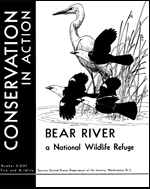United States Fish and Wildlife Service

United States Fish and Wildlife Service: Publications
Date of this Version
6-2006
Abstract
The U.S. federal government has developed lists of plant species that occur in wetlands. The initial purpose of these lists was to enumerate plants that grow in wetlands and that could be used to identify wetlands according to the U.S. Fish and Wildlife Service’s wetland classification system. The first list was generated in 1976 by the Service, and since that time, the list has undergone several iterations as more information was reviewed or became available through field investigations and scientific research. Two lists are currently published and available for use: a 1988 list and a 1996 draft list. The latter list represents an improvement based on nearly 10 years of field work by the four signatory agencies plus comments from other agencies, organizations, wetland scientists, and others. The national list was generated from 13 regional lists. These data have not been summarized previously; this note provides an interregional summary of vital statistics. The 1988 list included 6,728 species, while the 1996 list has nearly 1,000 additions for a total of 7,662 species (a 14% increase). Roughly one-third of the nation’s vascular plants have some potential for being hydrophytes—plants growing in water or on a substrate that is at least periodically deficient in oxygen due to excessive wetness. Each species on the list is assigned an indicator status reflecting its frequency of occurrence in wetlands: 1) obligate (OBL; >99% of time in wetlands), 2) facultative wetland (FACW; 67– 99% in wetlands), 3) facultative (FAC; 34–66%), 4) facultative upland (FACU; 1–33%), and 5) upland (UPL; <1%). From 1988 to 1996, the regional lists of potentially hydrophytic species increased by more than 39 percent in three regions: Caribbean, North Plains, and Central Plains. The percent of OBL, FACW, and FAC species on the lists decreased in the Northeast and Hawaii. The percent of OBL and FACW species also decreased in the Southeast and Northwest. The number of OBL species declined in all but three regions, whereas the number of FACU species added to the lists increased in all regions except Hawaii. The regional ‘‘wetland plant’’ lists have been used to help identify plant communities that possess a predominance of wetland indicator plants (i.e., a positive indicator of hydrophytic vegetation) and to identify wetlands that can be recognized solely based on their vegetation.


Comments
Published in WETLANDS, Vol. 26, No. 2, June 2006, pp. 624–634.